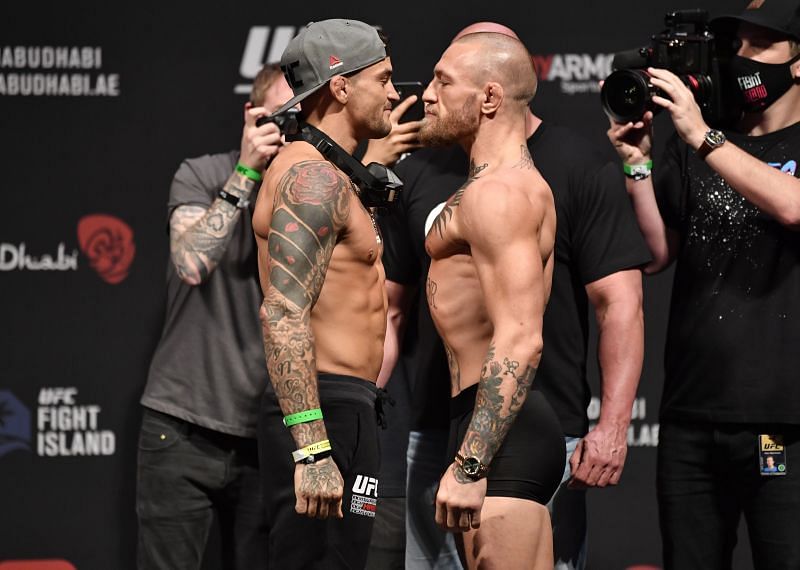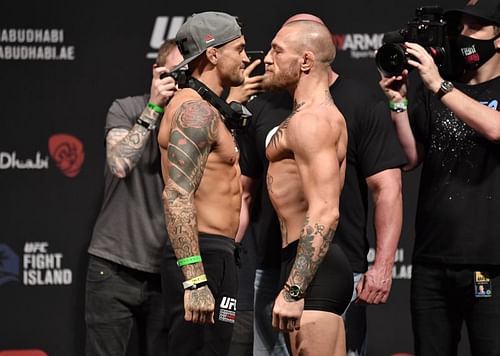
3 reasons why Conor McGregor vs Dustin Poirier 3 won't go the distance

Conor McGregor and Dustin Poirier's long-standing rivalry is about to see its end in their third fight against each other at UFC 264 on July 10, 2021 at T-Mobile Arena in Paradise, Nevada.
The rivalry started with their featherweight fight at UFC 178. McGregor won this fight in the first round by TKO. Seven years later, the two faced each other at UFC 257 where Poirier avenged his loss with a third-round TKO.
With the scores tied at 1-1, both fighters have agreed to settle their feud in a third fight. Needless to say, this fight will be explosive and there's no chance of it going to the judges' score cards. Here are 3 reasons why Conor McGregor vs Dustin Poirier 3 won't go the distance:
3) McGregor and Poirier have ended most of their previous fights early
Out of his 27 professional MMA fights, 16 of McGregor's fights have ended in the first round owing to his proficiency in striking. Only eight of his fights have ended in the second round but the number of times they went any further can be counted on just three fingers.
No McGregor made it past the end of the second round before he joined the UFC. It was only then that his fights crossed that threshold, starting with his second in the UFC against Max Holloway, which ended in the third round. His second scrap with Nate Diaz was the first time Conor McGregor saw himself going the distance and his infamous fight with Khabib Nurmagomedov saw a fourth-round finish.
While Dustin Poirier's finishes didn't come as early, the majority of his fights have ended in the first round. Poirier went the distance several times before facing McGregor at UFC 178. After this fight, he moved up to lightweight from featherweight and with the advantage of going into his fights as a bigger fighter, he only saw four of his fights going to the judges' score cards.
Poirier is a fighter who starts slow to find his rhythm as opposed to McGregor who looks for precise shots to end his fights quickly. But since his return to lightweight, once Poirier finds his rhythm, he almost always ends his fights at that instant owing to his size and ability to brawl.
2) McGregor's change of stance would encourage both to engage
In recent fights, McGregor has made tweaks to his fighting stance. He has moved away from his usual stance where he used to hold his body and head upright and a guard no higher than the shoulders. After the tweaks, you can see McGregor's head and body leaning forward with a high guard and square body position.
This stance resembles that of famous fighters in heavyweight boxing like 'Iron' Mike Tyson and Joe Frazier. But McGregor did not do what this stance was meant for in his previous fight with Poirier at UFC 257. It allows fighters to make a swift entry inside the opponent's reach and make relentless volume attacks.
If McGregor chooses to stick to this stance while adapting his style to make the most of it in his third fight with Poirier, it is sure to encourage more action in the pocket. Poirier, with his love for brawling, will be happy to oblige if McGregor enters the pocket. We can be sure that this stance will bring the fight to an early end with powerful strikes being exchanged there.
1) Poirier brings grappling into the mix
While Poirier hasn't ended his fights early with strikes as often as McGregor has, he has some submission wins on his resume. Bringing grappling into the mix can prevent the fight from going the distance.
McGregor is known to have a weak cardio and grappling game. If Poirier does not see himself ending the fight with strikes, there's no reason for him to hold back on taking the fight to the ground. Provided McGregor gases out again, there is a big opening for Poirier to take McGregor down and force a finish by submission.